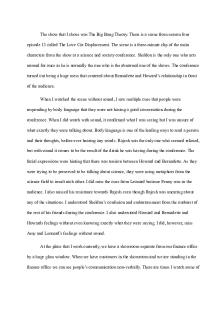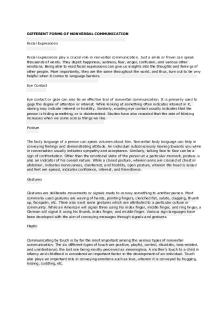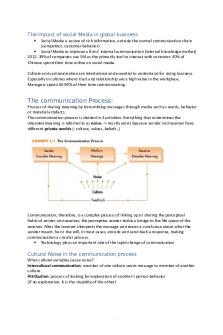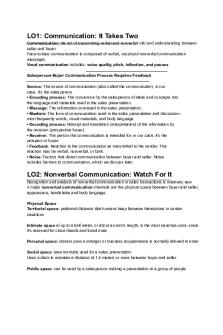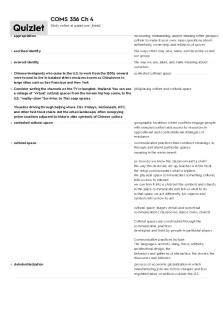Chapter 4 Nonverbal Communication PDF

| Title | Chapter 4 Nonverbal Communication |
|---|---|
| Author | bob makrly |
| Course | First Course Japanese |
| Institution | City Colleges of Chicago |
| Pages | 19 |
| File Size | 265.6 KB |
| File Type | |
| Total Downloads | 37 |
| Total Views | 194 |
Summary
its a sg...
Description
CHAPTER 4 NONVERBAL COMMUNICATION Adapted by Mohammed Ala-Uddin, James Madison University, 2020 Licensed under CC-BY-SA 4.0, https://vivaopen.oercommons.org/courseware/lesson/1535
Principles and Functions of Nonverbal Communication 62 Nonverbal Communication Conveys Important Information 62 Nonverbal Communication Is More Involuntary than Verbal 63 Nonverbal Communication Is More Ambiguous 63 Nonverbal Communication Is More Credible 64
Functions of Nonverbal Communication 64 Nonverbal Communication Conveys Meaning 64 Nonverbal Communication Influences Others 65 Nonverbal Communication Regulates Conversational Flow 66 Nonverbal Communication Affects Relationships 66 Nonverbal Communication Expresses Our Identities 67
Types of Nonverbal Communication 68 Kinesics 68 Gestures 68 Head Movements and Posture 69 Eye Contact 69 Facial Expressions 70 Haptics 70 Vocalics 71 Proxemics 72 PROXEMIC DISTANCES 72 PUBLIC SPACE 72 SOCIAL SPACE 72 PERSONAL SPACE 72 INTIMATE SPACE 72
Chronemics 73 Personal Presentation and Environment 74
Nonverbal Communication Competence 75 Guidelines for Sending Nonverbal Messages 76 NONVERBAL COMMUNICATION IS MULTICHANNEL 76 NONVERBAL COMMUNICATION AFFECTS OUR INTERACTIONS 76 NONVERBAL COMMUNICATION REGULATES CONVERSATIONS 76 NONVERBAL COMMUNICATION RELATES TO LISTENING 77 NONVERBAL COMMUNICATION RELATES TO IMPRESSION MANAGEMENT 77
Guidelines for Interpreting Nonverbal Messages 77 RECOGNIZE THAT CERTAIN NONVERBAL SIGNALS ARE RELATED 77 READ NONVERBAL CUES IN CONTEXT 78
CHAPTER 4
NONVERBAL COMMUNICATION When we think about communication, we most often focus on how we exchange information using words. While verbal communication is important, humans relied on nonverbal communication for thousands of years before we developed the capability to communicate with words. Nonverbal communication is a process of generating meaning using behavior other than words. Rather than thinking of nonverbal communication as the opposite of or as separate from verbal communication, it’s more accurate to view them as operating side by side—as part of the same system. The content and composition of verbal and nonverbal communication also differs. In terms of content, nonverbal communication tends to do the work of communicating emotions more than verbal. In terms of composition, although there are rules of grammar that structure our verbal communication, no such official guides govern our use of nonverbal signals. Likewise, there are not dictionaries and thesauruses of nonverbal communication like there are with verbal symbols. Finally, whereas we humans are unique in our capacity to abstract and transcend space and time using verbal symbols, we are not the only creatures that engage in nonverbal communication. Owen Hargie, Skilled Interpersonal Interaction: Research, Theory, and Practice, 5th ed. (London: Routledge, 2011), 49. These are just some of the characteristics that differentiate verbal communication from nonverbal, and in the remainder of this chapter, we will discuss in more detail the principles, functions, and types of nonverbal communication and conclude with some guidance on how to improve our nonverbal communication competence.
Principles and Functions of Nonverbal Communication A channel is the sensory route on which a message travels. Verbal, or word-based, communication usually only relies on one channel, because spoken language is transmitted through sound and picked up by our ears, and text based communication is picked up by our eyes. All five of our senses, on the other hand, can take in nonverbal communication. Since most of our communication relies on visual and auditory channels, those will be the primary focus. But we can also receive messages and generate meaning through touch, taste, and smell To define further nonverbal communication, we need to distinguish between vocal and verbal aspects of communication. Verbal and nonverbal communication include both vocal and non-vocal elements. A vocal element of verbal communication is spoken words—for example, “Come back here.” A vocal element of nonverbal communication is paralanguage. Paralanguage is the vocalized but not verbal part of a spoken message, such as speaking rate, volume, and pitch. (In other words, paralanguage is everything that comes out of your throat as a sound, but is not a word.) Non-vocal elements of verbal communication include the use of unspoken symbols to convey meaning. Non-vocal elements of nonverbal communication include body language such as gestures, facial expressions, and eye contact. Gestures are non-vocal and nonverbal since most of them do not refer to a specific word like a written or signed symbol does.
Nonverbal Communication Conveys Important Information You have probably heard that more meaning is generated from nonverbal communication than from verbal. Some studies have claimed that 90 percent of our meaning is derived from nonverbal signals, 62
but more recent and reliable findings claim that it is closer to 65 percent (Guerrero & Floyd, 2006). We may rely more on nonverbal signals in situations where verbal and nonverbal messages conflict and in situations where emotional or relational communication is taking place (Hargie, 2011). For example, when someone asks a question and we are not sure about the “angle” they are taking, we may hone in on nonverbal cues to fill in the meaning. For example, the question “What are you doing tonight?” could mean any number of things, but we could rely on posture, tone of voice, and eye contact to see if the person is just curious, suspicious, or hinting that they would like company for the evening. We also put more weight on nonverbal communication when determining a person’s credibility. For example, if a classmate delivers a speech in class and her verbal content seems well researched and unbiased, but her nonverbal communication is poor (her voice is monotone, she avoids eye contact, she fidgets), she will likely not be viewed as credible. Conversely, in some situations, verbal communication might carry more meaning than nonverbal. In interactions where information exchange is the focus, at a briefing at work, for example, verbal communication likely accounts for much more of the meaning generated. Despite this exception, a key principle of nonverbal communication is that it often takes on more meaning in interpersonal and/or emotional exchanges.
Nonverbal Communication Is More Involuntary than Verbal We verbally communicate involuntarily in some instances. These types of exclamations are often verbal responses to a surprising stimulus. For example, we say “owww!” when we stub our toe or scream “stop!” when we see someone heading toward danger. Involuntary nonverbal signals are much more common. Although most nonverbal communication is not completely involuntary, it is more below our consciousness than verbal communication. Therefore, it is more difficult to control. The involuntary nature of much nonverbal communication makes it more difficult to control or “fake.” For example, although you can consciously smile a little and shake hands with someone when you first see them, it is difficult to fake that you are “happy” to meet someone. Nonverbal communication leaks out in ways that expose our underlying thoughts or feelings. Spokespeople, lawyers, or other public representatives who are the “face” of a politician, celebrity, corporation, or organization must learn to control their facial expressions and other nonverbal communication so they can effectively convey the message of their employer or client without having their personal thoughts and feelings leak through. Poker players, therapists, police officers, doctors, teachers, and actors are also in professions that often require them to have more awareness of and control over their nonverbal communication. Have you ever tried to conceal your surprise, suppress your anger, or act joyful even when you weren’t? Most people whose careers don’t involve conscious manipulation of nonverbal signals find it difficult to control or suppress them. While we can consciously decide to stop sending verbal messages, our nonverbal communication always has the potential of generating meaning for another person, whether we mean it to or not. The teenager who decides to shut out his dad and not communicate with him still sends a message with his “blank” stare (still a facial expression) and lack of movement (still a gesture). In this sense, nonverbal communication is “irrepressible” (Andersen, 1999).
Nonverbal Communication Is More Ambiguous We know that the symbolic and abstract nature of language can lead to misunderstandings, but nonverbal communication is even more ambiguous. As with verbal communication, most of our nonverbal signals can be linked to multiple meanings, but unlike words, many nonverbal signals do not 63
have any one specific meaning. If you have ever had someone wink at you and did not know why, you have probably experienced this uncertainty. Did they wink to express their affection for you, their pleasure with something you just did, or because you share some inside knowledge or joke? Just as we look at context clues in a sentence or paragraph to derive meaning from a particular word, we can look for context clues in various sources of information like the physical environment, other nonverbal signals, or verbal communication to make sense of a particular nonverbal cue. Unlike verbal communication, however, nonverbal communication does not have explicit rules of grammar that bring structure, order, and agreed- on patterns of usage. Instead, we implicitly learn norms of nonverbal communication, which leads to greater variance. In general, we exhibit more idiosyncrasies in our usage of nonverbal communication than we do with verbal communication, which also increases the ambiguity of nonverbal communication.
Nonverbal Communication Is More Credible Although we can rely on verbal communication to fill in the blanks sometimes left by nonverbal expressions, we often put more trust into what people do over what they say. This is especially true in times of stress or danger when our behaviors become more instinctual and we rely on older systems of thinking and acting that evolved before our ability to speak and write (Andersen, 1999). This innateness creates intuitive feelings about the genuineness of nonverbal communication, and this genuineness relates back to our earlier discussion about the sometimes involuntary and often subconscious nature of nonverbal communication. An example of the innateness of nonverbal signals can be found in children who have been blind since birth but still exhibit the same facial expressions as other children. In short, the involuntary or subconscious nature of nonverbal communication makes it less easy to fake, which makes it seem more honest and credible. We will learn more about the role that nonverbal communication plays in deception later in this chapter.
Functions of Nonverbal Communication A primary function of nonverbal communication is to convey meaning by reinforcing, substituting for, or contradicting verbal communication. Nonverbal communication is also used to influence others and regulate conversational flow. Perhaps even more important are the ways in which nonverbal communication functions as a central part of relational communication and identity expression.
Nonverbal Communication Conveys Meaning Nonverbal communication conveys meaning by reinforcing, substituting for, or contradicting verbal communication. As we’ve already learned, verbal and nonverbal communication are two parts of the same system that often work side by side, helping us generate meaning. In terms of reinforcing verbal communication, gestures can help describe a space or shape that another person is unfamiliar with in ways that words alone cannot. Gestures also reinforce basic meaning—for example, pointing to the door when you tell someone to leave. Facial expressions reinforce the emotional states we convey through verbal communication. For example, smiling while telling a funny story better conveys your emotions (Hargie, 2011). Vocal variation can help us emphasize a particular part of a message, which helps reinforce a word or sentence’s meaning. For example, saying, “How was your weekend?” conveys a different meaning than “How was your weekend?” Nonverbal communication can substitute for verbal communication in a variety of ways. Nonverbal 64
communication can convey a great deal of meaning when verbal communication is not effective because of language barriers. Language barriers are present when a person has not yet learned to speak or loses the ability to speak. For example, babies who have not yet developed language skills make facial expressions, at a few months old, that are similar to those of adults and therefore can generate meaning (Oster, Hegley, & Nagel, 1992). People who have developed language skills but cannot use them because they have temporarily or permanently lost them can still communicate nonverbally. Although it is always a good idea to learn some of the local language when you travel, gestures such as pointing or demonstrating the size or shape of something may suffice in basic interactions. Nonverbal communication is also useful in a quiet situation where verbal communication would be disturbing; for example, you may use a gesture to signal to a friend that you are ready to leave the library. Crowded or loud places can also impede verbal communication and lead people to rely more on nonverbal messages. Getting a server or bartender’s attention with a hand gesture is definitely more polite than yelling, “Hey you!” Finally, there are just times when we know it is better not to say something aloud. If you want to point out a person’s unusual outfit or signal to a friend that you think his or her date is a loser, you are probably more likely to do that nonverbally. Last, nonverbal communication can convey meaning by contradicting verbal communication. As we learned earlier, we often perceive nonverbal communication to be more credible than verbal communication. This is especially true when we receive mixed messages, or messages in which verbal and nonverbal signals contradict each other. For example, a person may say, “You can’t do anything right!” in a mean tone but follow that up with a wink, which could indicate the person is teasing or joking. Mixed messages lead to uncertainty and confusion on the part of receivers, which leads us to look for more information to try to determine which message is more credible. If we are unable to resolve the discrepancy, we are likely to react negatively and potentially withdraw from the interaction (Hargie, 2011). Persistent mixed messages can lead to relational distress and hurt a person’s credibility in professional settings.
Nonverbal Communication Influences Others Nonverbal communication can be used to influence people in a variety of ways, but the most common way is through deception. Deception is typically thought of as the intentional act of altering information to influence another person, which means that it extends beyond lying to include concealing, omitting, or exaggerating information. While verbal communication is to blame for the content of the deception, nonverbal communication partners with the language through deceptive acts to be more convincing. Since most of us intuitively believe that nonverbal communication is more credible than verbal communication, we often intentionally try to control our nonverbal communication when we are engaging in deception. Likewise, we try to evaluate other people’s nonverbal communication to determine the veracity of their messages. Students initially seem surprised when we discuss the prevalence of deception, but their surprise diminishes once they realize that deception is not always malevolent, mean, or hurtful. Deception obviously has negative connotations, but people engage in deception for many reasons (to excuse our own mistakes, be polite to others, or influence others’ behaviors or perceptions). The fact that deception served an important evolutionary purpose helps explain its prevalence among humans today. Species that are capable of deception have a higher survival rate. Other animals engage in nonverbal deception that helps them attract mates, hide from predators, and trap prey 65
(Andersen, 1999). To put it bluntly, the better at deception a creature is, the more likely it is to survive. So, over time, the humans that were better liars were the ones that got their genes passed on. However, the fact that lying played a part in our survival as a species does not give us a license to lie. Aside from deception, we can use nonverbal communication to “take the edge off” a critical or unpleasant message in an attempt to influence the reaction of the other person. We can also use eye contact and proximity to get someone to move or leave an area. For example, hungry diners waiting to snag a first-come-first-serve table in a crowded restaurant send messages to the people who have already eaten and paid that it’s time to go. People on competition reality television shows like Survivor and Big Brother play what they have come to term a “social game.” The social aspects of the game involve the manipulation of verbal and nonverbal cues to send strategic messages about oneself in an attempt to influence others. Nonverbal cues such as length of conversational turn, volume, posture, touch, eye contact, and choices of clothing and accessories can become part of a player’s social game strategy. Although reality television is not a reflection of real life, people still engage in competition and strategically change their communication to influence others, making it important to be aware of how we nonverbally influence others and how they may try to influence us.
Nonverbal Communication Regulates Conversational Flow Conversational interaction has been likened to a dance, where each person has to make moves and take turns without stepping on the other’s toes. Nonverbal communication helps us regulate our conversations so we do not end up constantly interrupting each other or waiting in awkward silences between speaker turns. Pitch, which is a part of vocalics, helps us cue others into our conversational intentions. A rising pitch typically indicates a question and a falling pitch indicates the end of a thought or the end of a conversational turn. We can also use a falling pitch to indicate closure, which can be very useful at the end of a speech to signal to the audience that you are finished, which cues the applause and prevents an awkward silence that the speaker ends up filling with “That’s it” or “Thank you.” We also signal our turn is coming to an end by stopping hand gestures and shifting our eye contact to the person who we think will speak next (Hargie, 2011). Conversely, we can “hold the floor” with nonverbal signals even when we are not exactly sure what we are going to say next. Repeating a hand gesture or using one or more verbal fillers can extend our turn even though we are not verbally communicating at the moment.
Nonverbal Communication Affects Relationships To relate successfully to other people, we must possess some skill at encoding and decoding nonverbal communication. The nonverbal messages we send and receive influence our relationships in positive and negative ways and can work to bring people together or push them apart. Nonverbal communication in the form of tie signs, immediacy behaviors, and expressions of emotion are just three of many examples that illustrate how nonverbal communication affects our relationships. Immediacy behaviors play a central role in bringing people together. Some scholars have identified them as the most important function of nonverbal communication (Andersen & Andersen, 2005). Immediacy behaviors are verbal and nonverbal behaviors that lessen real or perceived physical and psychological distance between communicators and include things like smiling, nodding, making eye contact, and occasionally engaging in social, polite, or profe...
Similar Free PDFs
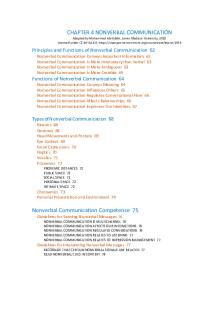
Chapter 4 Nonverbal Communication
- 19 Pages

6 - Nonverbal Communication
- 1 Pages

CH 5 HW: Nonverbal Communication
- 2 Pages
Popular Institutions
- Tinajero National High School - Annex
- Politeknik Caltex Riau
- Yokohama City University
- SGT University
- University of Al-Qadisiyah
- Divine Word College of Vigan
- Techniek College Rotterdam
- Universidade de Santiago
- Universiti Teknologi MARA Cawangan Johor Kampus Pasir Gudang
- Poltekkes Kemenkes Yogyakarta
- Baguio City National High School
- Colegio san marcos
- preparatoria uno
- Centro de Bachillerato Tecnológico Industrial y de Servicios No. 107
- Dalian Maritime University
- Quang Trung Secondary School
- Colegio Tecnológico en Informática
- Corporación Regional de Educación Superior
- Grupo CEDVA
- Dar Al Uloom University
- Centro de Estudios Preuniversitarios de la Universidad Nacional de Ingeniería
- 上智大学
- Aakash International School, Nuna Majara
- San Felipe Neri Catholic School
- Kang Chiao International School - New Taipei City
- Misamis Occidental National High School
- Institución Educativa Escuela Normal Juan Ladrilleros
- Kolehiyo ng Pantukan
- Batanes State College
- Instituto Continental
- Sekolah Menengah Kejuruan Kesehatan Kaltara (Tarakan)
- Colegio de La Inmaculada Concepcion - Cebu



